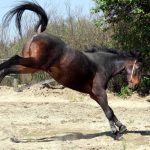What Does It Mean to Sore a Horse? Soring a horse is the practice of deliberately inflicting pain on its lower legs, hooves and fetlocks to exaggerate the high-stepping gait known as the “Big Lick” in Tennessee Walking Horses. It’s done by using caustic chemicals or sharp objects, such as metal chains or nails, to irritate the tender skin between a horse’s hoof and leg. This painful process may also involve cutting away protective layers of tissue from around their hooves and ankles to make them even more sensitive.
The result is an exaggerated lift with each step that increases its value for show purposes. Soring has been condemned by animal welfare organizations since it causes harm both physically and psychologically to horses forced into this unnatural way of walking. It can lead to long-term physical trauma including lameness, infection, bone deformities and permanent nerve damage if not stopped immediately.
Soring a horse is an incredibly cruel and illegal practice that involves inflicting pain on the horse’s legs or hooves in order to create an exaggerated, unnatural gait. This can be done through a variety of methods, such as using chemical irritants, caustic chemicals, or even metal chains or sharp objects directly on their skin. Not only does this cause immense physical suffering for the animal but it also puts them at risk for serious long-term health issues and could lead to permanent damage.
It is important to point out that soring goes against basic principles of horse handling and therefore should never be practiced under any circumstance.
How to Sore a Horse
Soring a horse is a practice that involves causing physical pain to the animal’s hooves and legs in order to make it perform certain gaits. It is an illegal act, punishable by fines or even jail time in some states, and should never be done. If you are looking to sore your horse, the best thing to do is talk with a certified trainer who has experience with sored horses so they can provide you with proper guidance on how to safely train your equine partner without resorting to unethical practices such as soring.

What Happens When a Horse is Sored?
Soring is an illegal practice in the United States that involves deliberately inflicting pain on a horse’s legs or hooves in order to make them more sensitive and increase their performance during shows. The process can involve using caustic chemicals, heated objects, or sharp tools to cause discomfort and fear. Horses that have been sored exhibit signs of distress including lameness, reluctance to move forward, increased sensitivity when touched, and aggressive behavior towards handlers.
Additionally, horses may display head tossing and other behaviors indicative of discomfort or pain. The long-term effects of soring are severe for the animal; not only does it cause physical trauma but also mental anguish due to the association between humans and pain. Soring can lead to permanent damage such as scarring on the legs or feet as well as chronic joint problems due to uneven pressure placed on joints from limping caused by soreness.
Moreover, horses who have been subjected to this cruel treatment often experience psychological issues such as anxiety triggered by certain sounds or smells associated with the abuse which further disrupt normal training processes. Ultimately, soring is an egregious act that should never be tolerated; if you suspect someone of engaging in this activity report it immediately so proper authorities can intervene and protect these animals from suffering any longer than necessary.
Do People Still Sore Horses?
Yes, people still sore horses! Horseback riding is an exhilarating and timeless activity that has been a part of human culture for thousands of years. Today, horseback riding remains one of the most popular recreational activities in the world.
People enjoy not only the thrill of galloping across open fields on top of a powerful animal but also the companionship and connection to nature that comes with it. Riding can be done through various disciplines from dressage to show jumping, western pleasure to cross-country trail rides, or simply just leisurely hacks around your local neighborhood park. Not only does riding provide physical exercise for both horse and rider, but it also helps build confidence as riders learn how to control their steed while out in public spaces where they may come into contact with other animals or people passing by.
Whether you’re looking for competition-level training or just want a gentle ride down a country lane – there are few experiences quite like being atop a horse and feeling its strength beneath you as you explore the great outdoors together!
How Do You Know If Your Horse Is Sored?
If you think your horse may be sored, there are a few tell-tale signs to look for. If your horse shows any of these signs while you are grooming him or her, it could indicate that they may have been sored. These include heat and/or swelling around the hooves; sensitivity when manipulating the pasterns, fetlocks, or coronets; resistance to flexion tests of the lower limb joints; excessive gait changes such as lifting one front foot higher than normal in order to avoid pain, etc.
; an unwillingness to move forward in response to leg aids; limping during exercise sessions or after being ridden for short periods of time; and visible lesions on the skin or underlying tissue caused by irritation from products used for sorting horses. If your horse exhibits any of these symptoms then you should contact a veterinarian immediately and get them checked out so that proper treatment can be provided if necessary.
Why is Soring Horses Bad?
Soring horses is an illegal and cruel practice that involves intentionally inflicting pain on a horse’s legs or hooves in order to exacerbate its gait. This often results in the horse displaying an exaggerated, high-stepping gait known as the “Big Lick” when being shown in certain disciplines such as Saddlebreds, Tennessee Walking Horses and Spotted Saddle Horses. Unfortunately, this behavior can be seen at shows across the country and it’s not only bad for the animal but also bad for our sport.
Soring causes tremendous suffering for these animals who are unable to vocalize their discomfort or tell us what they need; instead they must endure extreme physical pain with no relief. The chemicals used to sorer a horse are often caustic substances like kerosene which may cause further damage if left untreated. In addition to causing physical harm, sorting can lead to psychological trauma as well because of fear associated with having painful objects attached to their bodies or being put into unfamiliar positions during training sessions.
It can also prevent them from achieving optimal performance due to decreased range of motion caused by stiffened muscles and joints resulting from nerve damage caused by sorting techniques.
A sore poll in a horse? How do I know if I have a sore horse? How do I check a sore horse? Sore horse
Conclusion
In conclusion, soring a horse is an inhumane practice that should be stopped. Horses are beautiful and majestic creatures who deserve to live without pain and fear. By educating ourselves about the issue of soring horses, we can do our part towards ending this cruel act and protecting our four-legged friends from suffering needlessly.
Janet G Kulick is an experienced horse rider, trainer, and owner of the informative horse blog, Horseray.com. Her engaging writing style and wealth of knowledge on horse care, riding, and training make her a trusted source for horse enthusiasts worldwide.






